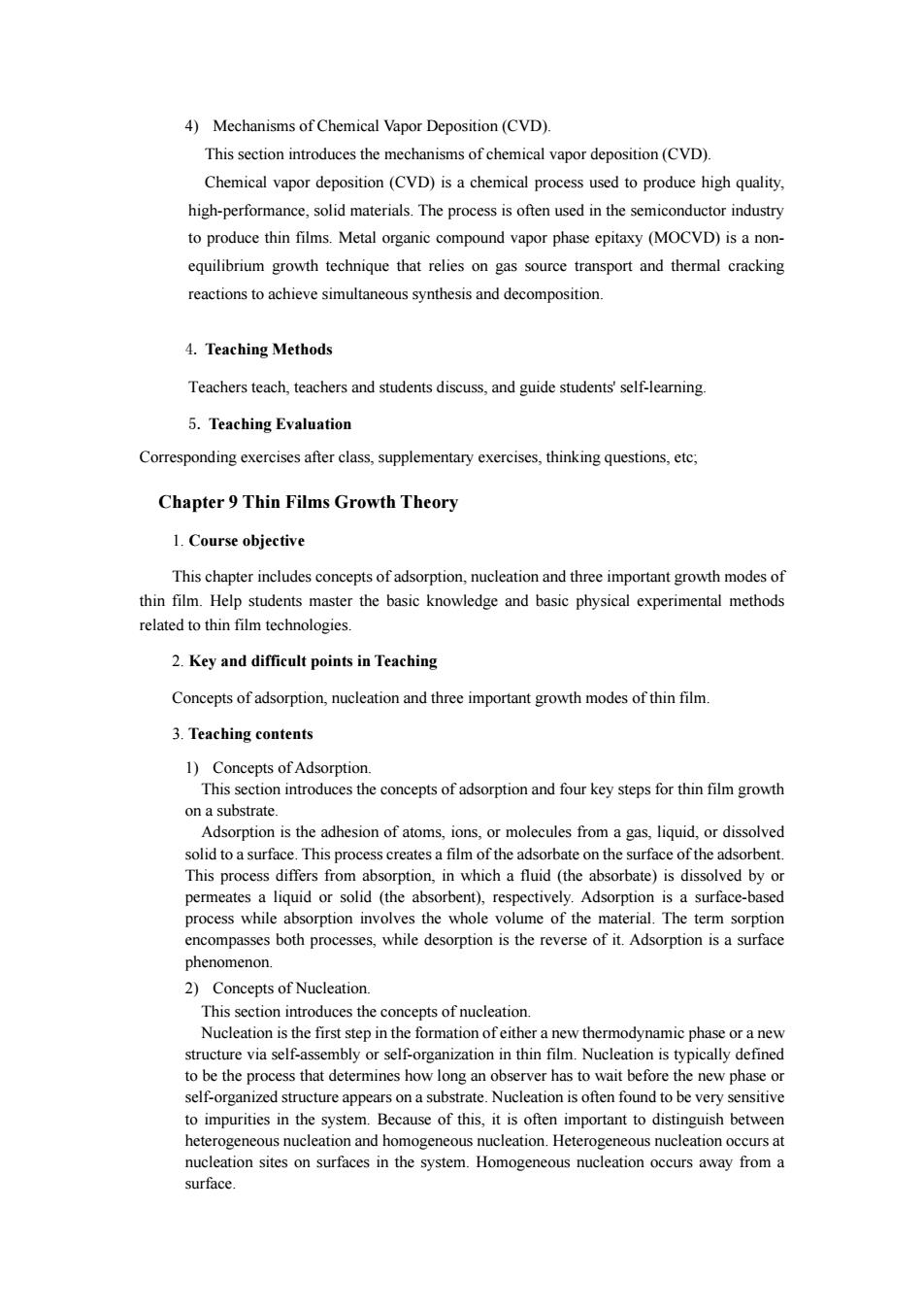正在加载图片...

4)Mechanisms of Chemical Vapor Deposition(CVD) This section introduces the mechanisms of chemical vapor deposition(CVD). Chemical vapor deposition (CVD)isa chemical process used to produce high quality high-performance,solid materials.The process is often used in the semiconductor industry toproduce thin films.Metal organic compound vapor phase epitaxy (MOCVD)isanon- equilibrium growth technique that relies on gas source transport and thermal cracking reactions to achieve simultaneous synthesis and decomposition. 4.Teaching Methods Teachers teach.teachers and students discuss.and guide students'self-learning 5.Teaching Evaluation Corresponding exercises after class,supplementary exercises,thinking questions,etc. Chapter9Thin Films Growth Theory 1.Course objective This chapter includes concepts of adsorption,nucleation and three important growth modes of thin film.Help students master the basic knowledge and basic physical experimental methods related to thin fim technologies. 2.Key and difficult points in Teaching Concepts of adsorption,nucleation and three important growth modes of thin film. 3.Teaching contents 1)Concepts of Adsorption This section introduces the concepts of adsorption and four key steps for thin film growth on a substrate. Adsorption is the adhesion of atoms,ions.or molecules from a gas,liquid,or dissolved solid to a surface.This process creates a film of the adsorbate on the surface of the adsorbent. This process differs from absorption,in which a fluid (the absorbate)is dissolved by or permeates a liquid or solid (the absorbent),respectively.Adsorption is a surface-based process while absorption involves the whole volume of the material.The term sorption encompasses both processes,while desorption is the reverse of it.Adsorption is a surface phenomenon 2)Concepts of Nucleation. This section introduces the concents of nucleation Nucleation is the first step in the formation of either a new thermodynamic phase or a new structure via self-assembly or self-organization in thin film.Nucleation is typically defined to be the process that determines how long an observer has to wait before the new phase or self-organized structure appears ona substrate.Nucleation is often found to be very sensitive to impurities in the system.Because of this,it is often important to distinguish between heterogeneous nucleation and homogeneous nucleation.Heterogeneous nucleation occurs at seson surtacesn the sysitm Homogeneous nucleaon ocurs ayroma4) Mechanisms of Chemical Vapor Deposition (CVD). This section introduces the mechanisms of chemical vapor deposition (CVD). Chemical vapor deposition (CVD) is a chemical process used to produce high quality, high-performance, solid materials. The process is often used in the semiconductor industry to produce thin films. Metal organic compound vapor phase epitaxy (MOCVD) is a nonequilibrium growth technique that relies on gas source transport and thermal cracking reactions to achieve simultaneous synthesis and decomposition. 4. Teaching Methods Teachers teach, teachers and students discuss, and guide students' self-learning. 5. Teaching Evaluation Corresponding exercises after class, supplementary exercises, thinking questions, etc; Chapter 9 Thin Films Growth Theory 1. Course objective This chapter includes concepts of adsorption, nucleation and three important growth modes of thin film. Help students master the basic knowledge and basic physical experimental methods related to thin film technologies. 2. Key and difficult points in Teaching Concepts of adsorption, nucleation and three important growth modes of thin film. 3. Teaching contents 1) Concepts of Adsorption. This section introduces the concepts of adsorption and four key steps for thin film growth on a substrate. Adsorption is the adhesion of atoms, ions, or molecules from a gas, liquid, or dissolved solid to a surface. This process creates a film of the adsorbate on the surface of the adsorbent. This process differs from absorption, in which a fluid (the absorbate) is dissolved by or permeates a liquid or solid (the absorbent), respectively. Adsorption is a surface-based process while absorption involves the whole volume of the material. The term sorption encompasses both processes, while desorption is the reverse of it. Adsorption is a surface phenomenon. 2) Concepts of Nucleation. This section introduces the concepts of nucleation. Nucleation is the first step in the formation of either a new thermodynamic phase or a new structure via self-assembly or self-organization in thin film. Nucleation is typically defined to be the process that determines how long an observer has to wait before the new phase or self-organized structure appears on a substrate. Nucleation is often found to be very sensitive to impurities in the system. Because of this, it is often important to distinguish between heterogeneous nucleation and homogeneous nucleation. Heterogeneous nucleation occurs at nucleation sites on surfaces in the system. Homogeneous nucleation occurs away from a surface